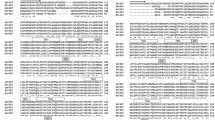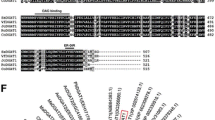Abstract
Rice bran oil (RBO), being naturally rich in antioxidants, is currently regarded as one of the health-beneficial edible oils. However, the RBO has essential linoleic acid (ω-6, C18:2) and α-linolenic acid (ω-3, C18:3) in nutritionally disproportionate level (~25:1), contrary to the WHO/FAO’s recommendation of ~5:1. Among few naturally occurring C18:3 enriched oil-seeds, Brassica juncea (Indian mustard) has almost equal proportion of ω-6 and ω-3 fatty acids in its oil due to the activity of microsomal ω-3 desaturase (Fad3), which converts C18:2–C18:3. Therefore, the full length Fad3 coding DNA sequence (CDS) was isolated from the developing seeds of B. juncea, functionally characterized and heterologously expressed for the nutritional enhancement of RBO. Sequence analysis revealed that the 1,134 bp long BjFad3 CDS corresponds to a polypeptide of 377 amino acids, which is highly (85–95 %) homologous to other known Fad3 enzymes of plant kingdom. The BjFad3 gene was initially characterized in transgenic tobacco to establish its linoleate desaturase activity. Thereafter, rice bran-specific expression of the BjFad3 was carried out to alter the fatty acid profile of RBO. Several independent transgenic lines of tobacco and rice plants were developed by Agrobacterium-mediated transformation. Standard molecular biological techniques were used to confirm the transgene integration in the respective genomes and subsequent in planta expression. The BjFad3 transgene expression correlated to the significant increase in C18:3 fatty acid content (up to tenfold) in both tobacco seed oil and RBO, and thereby improving the nutritionally desirable ω-6:ω-3 ratio (~2:1) in one of the transgenic rice lines.





Similar content being viewed by others
References
Abbadi A, Domergue F, Bauer J, Napier JA, Welti R, Zahringer U, Cirpus P, Heinz E (2004) Biosynthesis of very-long-chain polyunsaturated fatty acids in transgenic oilseeds: constraints on their accumulation. Plant Cell 16:2734–2748
Allen J (1987) Purification and fractionation of Poly (A)+ RNA. Methods Enzymol 152:254–261
Anai T, Koga M, Tanaka H, Kinoshita T, Rahman SM, Takagi Y (2003) Improvement of rice (Oryza sativa L.) seed oil quality through introduction of a soybean microsomal ω-3 fatty acid desaturase gene. Plant Cell Rep 21:988–992
Arumughan C, Skhariya R, Arora R (2004) Rice bran oil: an untapped health food. Inform 15:706–707
Ausman LM, Rong N, Nicolosi RJ (2005) Hypocholesterolemic effect of physically refined rice bran oil: studies of cholesterol metabolism and early atherosclerosis in hypercholesterolemic hamsters. J Nutr Biochem 16:521–529
Balachandran C, Mayamol PN, Thomas S, Sukumar D, Sundaresan A, Arumughan C (2008) An ecofriendly approach to process rice bran for high quality rice bran oil using supercritical carbon dioxide for nutraceutical applications. Bioresour Technol 99:2905–2912
Banerjee J, Maiti MK (2010) Functional role of rice germin-like protein1 in regulation of plant height and disease resistance. Biochem Biophys Res Commun 394:178–183
Bevan M, Barnes WM, Chitton MD (1983) Structure and transcription of the nopaline synthase gene region of T-DNA. Nucleic Acids Res 11(2):369–385
Bhattacharya S, Sinha S, Dey P, Das N, Maiti MK (2012) Production of nutritionally desirable fatty acids in seed oil of Indian mustard (Brassica juncea L.) by metabolic engineering. Phytochem Rev 11:197–209
Church GM, Gilbert W (1984) Genomic sequencing. Proc Natl Acad Sci 81:1991–1995
Doyle JJ, Doyle JL (1990) Isolation of plant DNA from fresh tissue. Focus 12:13–15
Eady S, Wallace A, Willis J, Scott R, Frampton C (2011) Consumption of a plant sterol-based spread derived from rice bran oil is effective at reducing plasma lipid levels in mildly hypercholesterolaemic individuals. Br J Nutr 15:1–12
Fits VL, Deakin EA, Hoge JH, Memelink J (2000) The ternary transformation system: constitutive virG on a compatible plasmid dramatically increases Agrobacterium-mediated plant transformation. Plant Mol Biol 43:495–502
Green AG (1986) A mutant genotype of flax (Linum usitatissimum L.) containing very low levels of linolenic acid in its seed oil. Can J Plant Sci 66:499–503
Griffiths G, Brechany EY, Jackson FM, Christie WW, Stymne S, Stobart AK (1996) Distribution and biosynthesis of fatty acids as substrates, LA for the production of GLA, and ALA for the production of OTA, stearidonic acid. Phytochemistry 43:381–386
Heinz E (1993) Biosynthesis of polyunsaturated fatty acids. In: Moore TSJ (ed) Lipid metabolism in plants. CRC Press, Boca Raton, pp 33–89
Horsch RB, Fry JE, Hoffman NL, Eichholtz D, Rogers SG, Fraley RTA (1985) Simple and general method for transferring genes into plants. Science 227:1229–1231
Jha JK, Sinha S, Maiti MK, Basu A, Mukhopadhyay UK, Sen SK (2007) Functional expression of an acyl carrier protein (ACP) from Azospirillum brasilense alters fatty acid profiles in Escherichia coli and Brassica juncea. Plant Physiol Biochem 45:490–500
Kumar KK, Maruthasalam S, Loganathan M, Sudhakar D, Balasubryamaniam P (2005) An improved Agrobacterium-mediated transformation protocol for recalcitrant elite indica rice cultivars. Plant Mol Biol Rep 23:67–73
Liu HL, Yin ZJ, Xiao L, Xu YN, Qu LQ (2012) Identification and evaluation of ω-3 fatty acid desaturase genes for hyperfortifying α-linolenic acid in transgenic rice seed. J Exp Bot 63:1–9
Logan AC (2004) Omega-3 fatty acids and major depression: a primer for the mental health professional. Lipids Health Dis 3:25
Los DA, Murata N (1998) Structure and expression of fatty acid desaturases. Biochim Biophys Acta 1394:3–15
Most MM, Tulley R, Morales S, Lefevre M (2005) Rice bran oil, not fiber, lowers cholesterol in humans. Am J Clin Nutr 81:64–68
Nair PMG, Kang IS, Moon BY, Lee CH (2009) Effects of low temperature stress on rice (Oryza sativa L.) plastid ω-3 desaturase gene, OsFAD8 and its functional analysis using T-DNA mutants. Plant Cell Tissue Organ Cult 98(1):87–96
Qu LQ, Xing YP, Liu WX, Xu XP, Song YR (2008) Expression pattern and activity of six glutelin gene promoters in transgenic rice. J Exp Bot 59:2417–2424
Reed DW, Taylor DC, Covello PS (1997) Metabolism of hydroxy fatty acids in developing seeds in the Genera Lesquerella (brassicaceae) and linum (linaceae). Plant Physiol 114:63–68
Reed DW, Schäfer UA, Covello PS (2000) Characterization of the Brassica napus extraplastidial linoleate desaturase by expression in Saccharomyces cerevisiae. Plant Physiol 122:715–720
Ross BM, Seguin J, Sieswerda LE (2007) Ω-3 fatty acids as treatments for mental illness: which disorders and which fatty acid? Lipids Health Dis 6:21
Rowland GG (1991) An EMS-induced low-linolenic-acid mutant in McGregor flax (Linum usitatissimum L.). Can J Plant Sci 71:393–396
Shanklin J, Cahoon EB (1998) Desaturation and related modifications of fatty acids. Annu Rev Plant Physiol Plant Mol Biol 49:611–641
Shimada T, Wakita Y, Otani M, Iba K (2000) Modification of fatty acid composition in rice plants by transformation with a tobacco microsomal x-3 fatty acid desaturase gene (NtFAD3). Plant Biotechnol 17:43–48
Simopoulos AP (2000) Symposium: role of poultry products in enriching the human diet with n-3 PUFA. Poult Sci 79:961–970
Sircar S, Kansra U (1998) Choice of cooking oils—myths and realities. J Indian Med Assoc 96:304–307
Somerville C, Browse J (1991) Plant lipids: metabolism, mutants, and membranes. Science 252:80–87
Stark AH, Crawford MA, Reifen R (2008) Update on alpha-linolenic acid. Nutr Rev 66:326–332
Thompson JD, Higgins DG, Gibson TJ (1994) Clustal W: improving the sensitivity of progressive multiple sequence alignment through sequence weighting, position-specific gap penalties and weight matrix choice. Nucleic Acids Res 22:4673–4680
Verwoerd TC, Dekker BM, Hoekema AA (1989) Small-scale procedure for the rapid isolation of plant RNAs. Nucleic Acids Res 17:2362–2371
Vrinten P, Hu Z, Munchinsky MA, Rowland G, Qiu X (2005) Two FAD3 desaturase genes control the level of linolenic acid in flax seed. Plant Physiol 139:79–87
Wan CH, Wilkins TA (1994) A modified hot borate method significantly enhances the yield of high-quality RNA from cotton (Gossypium hirsutum L.). Anal Biochem 223:7–124
Wijendran V, Hayes KC (2004) Dietary n-6 and n-3 fatty acid balance and cardiovascular health. Annu Rev Nutr 24:597–615
Wilson T, Nicolosi RJ, Woolfery B, Kritchevsky D (2007) Rice bran oil and oryzanol reduce plasma lipid and lipoprotein cholesterol concentrations and aortic cholesterol ester accumulation to a greater extent than ferulic acid in hypercholesterolemic hamsters. J Nutr Biochem 18(2):105–112
Xu Z, Hua N, Godber JS (2001) Antioxidant activity of tocopherols, tocotrienols, and γ-oryzanol components from rice bran against cholesterol oxidation accelerated by 2,2′-azobis (2-methylpropionamidine) dihydrochlorid. J Agric Food Chem 49(4):2077–2081
Yadav NS, Wierzbicki A, Aegerte M et al (1993) Cloning of higher plant ω-3 fatty acid desaturases. Plant Physiol 103:467–476
Acknowledgments
Authors sincerely thank Prof. S. K. Sen and Dr. A. Basu for their cooperation and help. We also acknowledge the technical help received from Mr. Sona Dogra, Mrs. Gayatri Aditya and Mr. Nitai Giri. Financial assistances in the form of research fellowship to S.B. from CSIR, to B.C. from UGC and research grant supports from the CSIR, New Delhi to carry out this work are also acknowledged.
Author information
Authors and Affiliations
Corresponding author
Additional information
Surajit Bhattacharya and Banani Chattopadhyaya have equally contributed to this work.
Rights and permissions
About this article
Cite this article
Bhattacharya, S., Chattopadhyaya, B., Koduru, L. et al. Heterologous expression of Brassica juncea microsomal ω-3 desaturase gene (BjFad3) improves the nutritionally desirable ω-6:ω-3 fatty acid ratio in rice bran oil. Plant Cell Tiss Organ Cult 119, 117–129 (2014). https://doi.org/10.1007/s11240-014-0518-0
Received:
Accepted:
Published:
Issue Date:
DOI: https://doi.org/10.1007/s11240-014-0518-0




